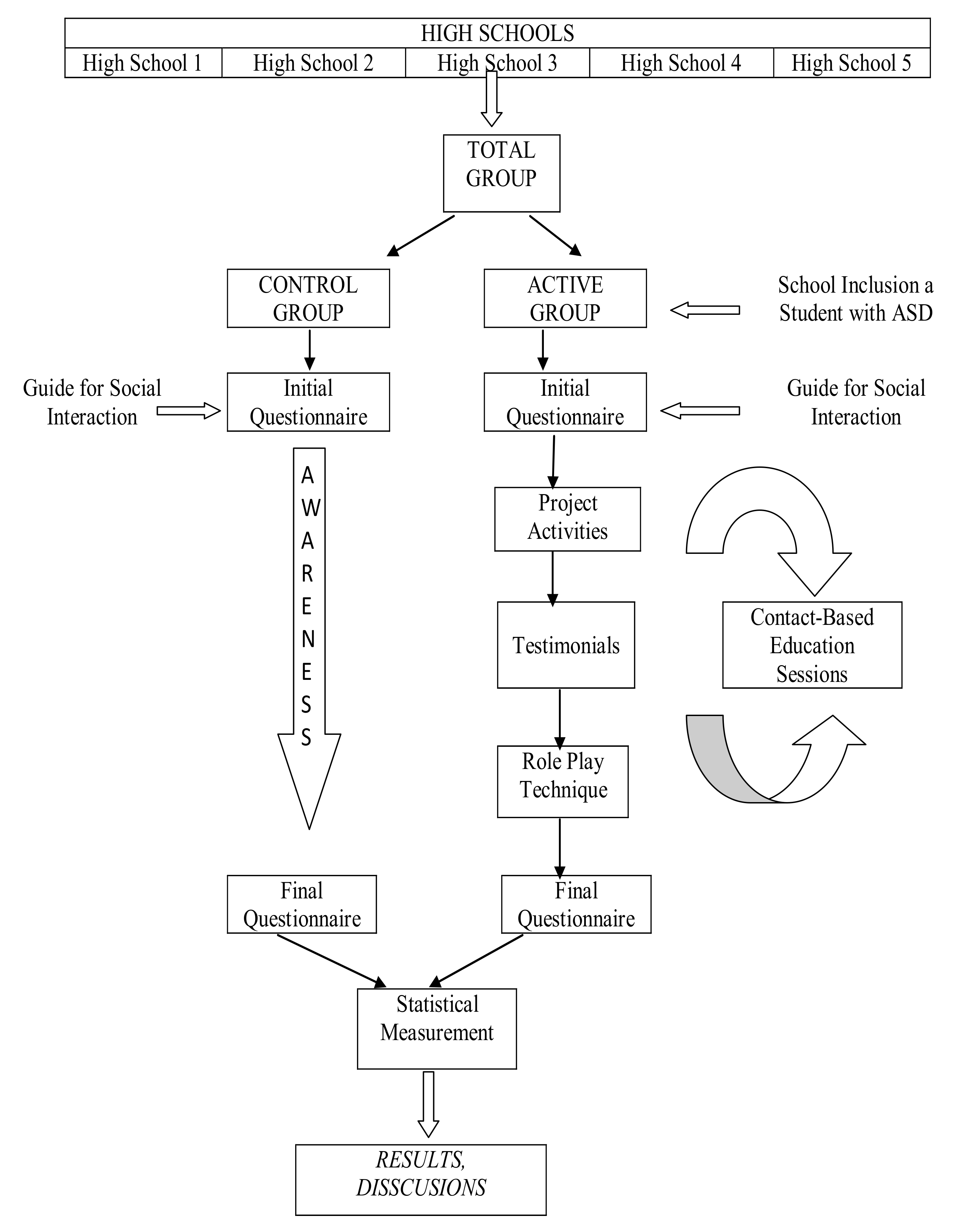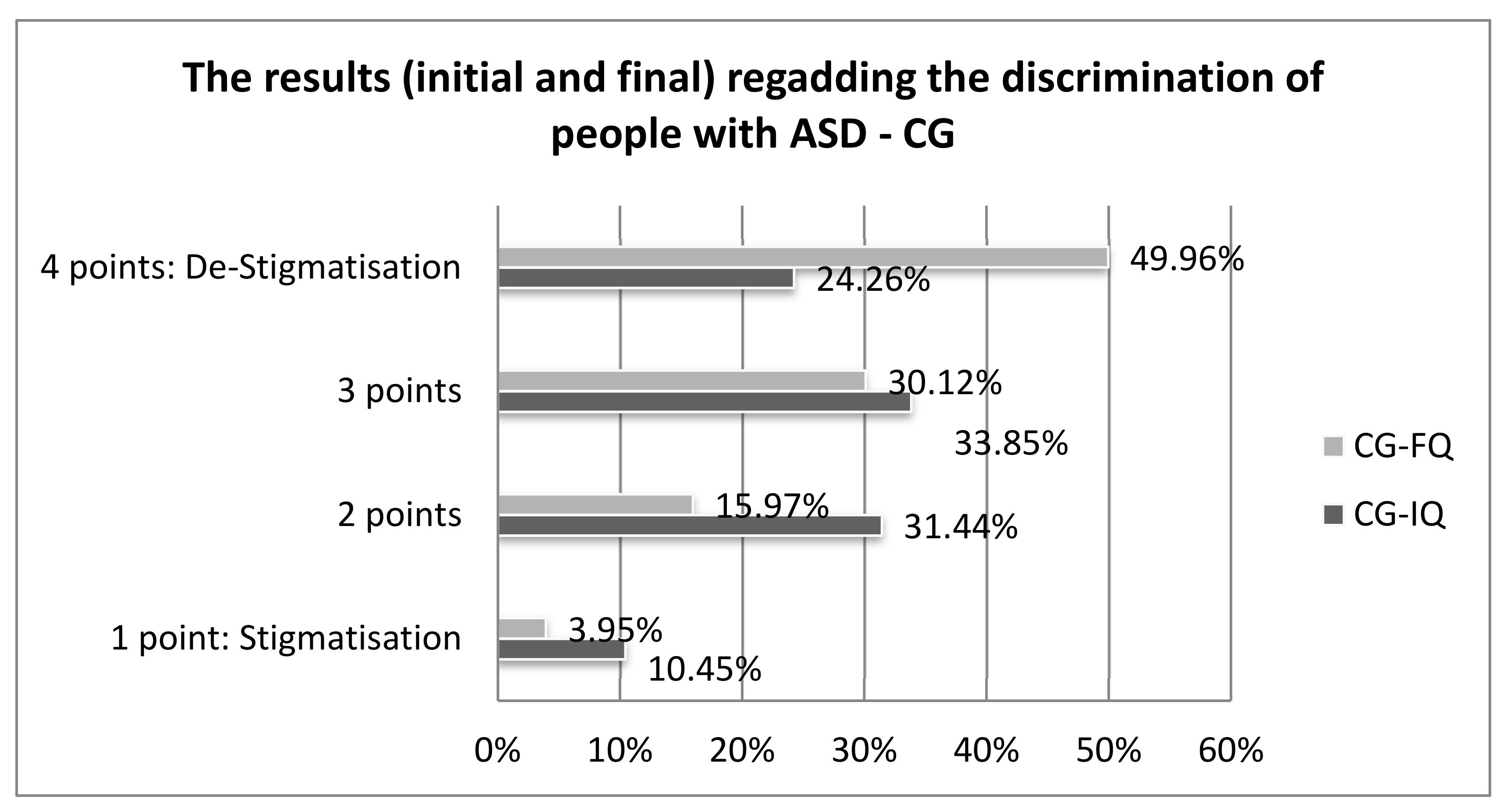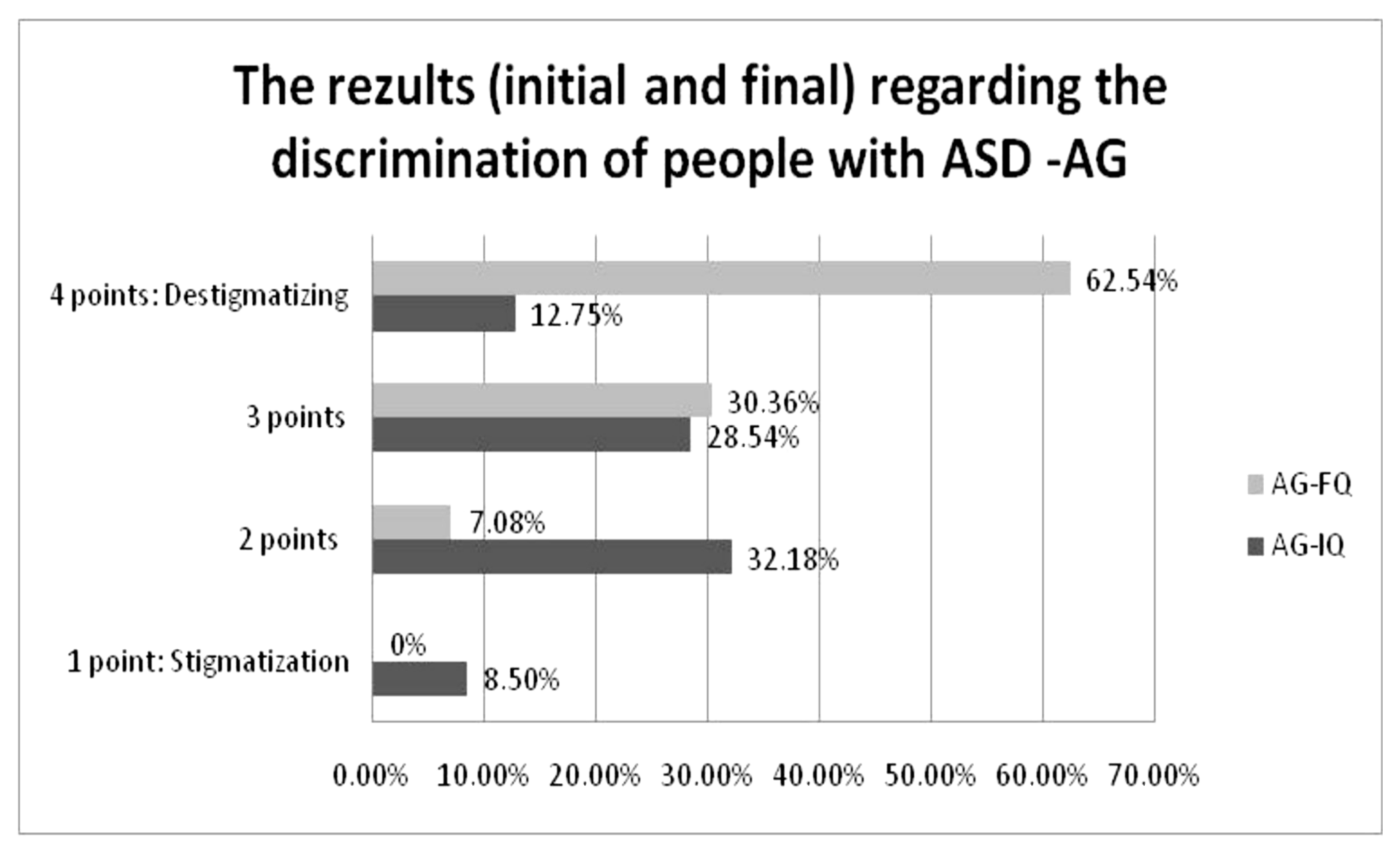1.1. Conceptual Framework
Autism is the most common disorder in a wider range of developmental disorders (high-functional autism, Asperger’s syndrome, Rett syndrome, etc.); therefore, the notion of autism spectrum disorder (ASD) is frequently used. Using the typology developed by the World Health Organization, International Statistical Classification of Diseases and Related Health Problems [
1], autism is a developmental mental and behavioral disorder that affects three areas of functioning: social interaction, communication and behavior. The most common symptoms are repetitive actions, communication difficulties and limited interactions. The disorder can be controlled with medication to control attention deficit, aggression or stereotypical behaviors, but the most important intervention is therapy, which should improve communication skills and reduce behavioral disorders [
2].
Currently, worldwide, there are estimated to be approximately 52 million cases diagnosed with ASD, meaning about 1–2% of children worldwide [
3]. In the US alone, in 2018–2019, over 8 million children aged 3–17 had a mental or behavioral health problem. Anxiety, behavioral disorders and depression are the most commonly diagnosed disorders [
4]. It is difficult to get a clear image of global prevalence, as there are substantial variations in current country estimates. Although there are these variations in estimates, studies have not shown that the variability of ASD can be explained by geographical, ethnic, cultural or socioeconomic factors [
5]. Depression, which is one of the most common mental illnesses, is commonly associated with ASD. If one in four people goes through at least one depressive episode at some point in their life, then within people with ASD, depression and discrimination are common problems [
6].
The study of this pathology has aroused the interest of specialists especially with the development of technologies that have been used successfully in effective interventions in people diagnosed with ASD. Robotic devices and mobile applications have been used to acquire cognitive, social and relational skills. An analysis of the literature (especially Web of Science) showed that after 2009, the volume of research increased considerably highlighting the advantages of using technologies in the recovery and therapeutic processes of people diagnosed with ASD [
7].
1.2. Discrimination and Stigmatization of Schoolchildren with Autism
The objective of this study is to analyze the school inclusion process of students with ASD by reducing discrimination and stigmatization through contact-based education sessions. This can be achieved through school projects.
Children with ASD are forced to adapt to social life without being able to use the adaptive elements of typical children. They encounter difficulties on several existential levels, and therefore educational projects aimed at school integration and optimizing the environment for these students must include as many of them as possible [
8]. Sometimes teachers prefer these children to attend special schools or question the benefits of the school inclusion process for students with disabilities, because they have to make a series of changes at the curricular, social or behavioral level [
9,
10]. There is a direct relationship between the architecture of spaces, classrooms or other school activities and the academic motivation, well-being or social relationships of students. The relationship between school spaces and the socioeducational well-being of the student is a challenge for schools that have to manage the process of educational inclusion of students with disabilities [
11]. Other authors pointed out that teachers can have favorable attitudes toward the school inclusion of students with disabilities if they participate in the decision-making process regarding the inclusion of these students in their classes [
12]. In the same time, social environment has a great impact on human beings, and by communicating, one can feel accepted and understood [
13].
The timing of the diagnosis of ASD has a strong impact on the family. From the moment of diagnosis, the quality of family life is affected by this disorder, whether we are talking about the health of family members, their personal and social life, relationships within the family or with the extended family or financial efforts necessary for therapy. An ecological approach to individual and environmental factors on the quality of family life may be relevant to understanding what parental resources should be targeted in recovery and adaptation programs for the school and social community of the child with ASD [
14,
15,
16,
17].
A family with a child with ASD experiences high levels of stress over long periods of time, far exceeding the level of stress in a family with neurotypical children or even in families whose children have been diagnosed with pathologies such as down syndrome, cerebral palsy, mental retardation or cystic fibrosis [
18,
19,
20]. Other stressors for parents and therapists, in daily management, may be the atypical eating behaviors (food selectivity) manifested by these children, which become targets that are difficult to overcome [
21]. During the pandemic caused by COVID-19, adapting to new routines was a major challenge, with a psychological impact. Parental stress and the emotional well-being of children with ASD have been unfavorably affected by social isolation [
22,
23]. After 2005, it has been observed that these aspects, stress and family problems, the way in which the relations between the parents are affected, aroused the interest of the scientific community, a fact noticed by the large number of studies published in Web of Science. How parents relate to the diagnosis received by the child influences the evolution of the therapy and socioeducational integration process [
24].
People diagnosed with mental disorders are discriminated against, are stigmatized [
25,
26], and can be victims of violence, aggression, and bullying. The effects of bullying are serious on children who fall victim to this phenomenon, ranging from depression, fear, anxiety, relationship difficulties, behavioral disorders, exclusion, and suicidal thoughts. Bullying and aggressive behaviors are more common in children with ASD than in typical children [
27]. The social manifestation of the feeling of shame can prevent those who are potential victims from obtaining the support they need to recover and actively participate in the life of the community. Stigma is one of the major sufferings of people with mental disabilities, affecting their quality of life [
28].
Before each stage of the child’s development of ASD, parents face a series of unknown problems that make it difficult to adapt to school: how the child is affected by changing environment, colleagues and teachers, how they perceive atypical behavior, and how it is affected the school year. The major changes in the life of a student with ASD are vulnerable moments. The fact that academic performance, no matter how high, does not ensure a degree of independence for the child can chronicle the stress of his family and endanger the child’s school inclusion [
29,
30]. Other challenges that children with ASD face are social isolation, rejection, lack of social and psychological support [
31]. Cognitively, the child diagnosed with autism spectrum disorders is at the level of his age and sometimes even higher. However, emotionally, the children have difficulty relating to those around them, or managing emotions, aspects that make them vulnerable in front of colleagues [
32,
33]. Therefore, the school inclusion of students with ASD must focus on overcoming these problems. It was found that research conducted after 2012 in the field of education focused on diagnosing children with ASD and their school inclusion. Prior to this period, the concerns of specialists were focused on their families, on the mothers of children with autism [
34].
School inclusion programs focus on the inclusion of students with special educational needs (SEN) in regular schools, alongside typical students for academic development and for acquiring social and emotional skills [
35].
Carrying out educational projects in which contact-based education (CBE) sessions are carried out increases the level of knowledge and awareness of the difficulties of adapting to the school environment and of community acceptance of students with ASD. Education through contact is an effective way to reduce stigma and discrimination against SEN students and their school inclusion [
36,
37,
38]. Experts in the field need to be increasingly aware of the need for strategies relevant to the inclusive education of children with disabilities, empirically supported by evidence-based practices [
39,
40]. For example, a certain choice of classroom management strategies (CMS) by teachers in the teaching program may reduce the impact of mental disabilities, such as ADHD, on school performance [
41]. The use of information and communication technology (ICT) in learning processes by teachers can be an effective method of educational inclusion of students with disabilities. The use of ICT is not only a method imposed by the circumstances of the COVID-19 pandemic but can be a key factor in sustainable educational programs for students with specific needs [
42,
43].
1.3. The Situation of Children with ASD in Romania
In Romania, there is no clear evidence of the number of children diagnosed with ASD. The Help Autism Foundation (NGO) estimates for 2019 a number of over 30,000 children with ASD, while over 1000 children are diagnosed annually (according to data provided by the Ministry of Health, National Institute of Mental Health). Of these, more than 10,500 children were of school age: 45% went to boarding schools, 30% to special schools, and 25% were not included in any form of education [
44]. At the moment, in Romania, a series of measures have been implemented through national policies for equal opportunities, prevention and treatment of people with disabilities. School inclusion measures have been proposed to target access to education for all children and children with SEN, including children with ASD. In line with the observance and encouragement of the principles and practices recommended by the Salamanca Declaration (1994), the implementation of educational programs by different educational systems must take into account the diversity of characteristics and learning needs of each child [
45].
In Romania, the implementation of policies for the inclusion of students with SEN was carried out in several stages: reorganization and functioning of the special education system and promotion of measures for the integration of students with SEN. In the medium and long term, there is no national strategy for these students. There is also, in addition to the chronic lack of specialists and support teachers, the lack of teaching materials, the inadequate curricula or one that is not alighted with what is required for children with special needs, with an emphasis on the amount of information accumulated rather than on the development of skills, focused on the pace of each child. A real problem for students with SEN is the transition from one schooling cycle to another (especially in high school), where the efforts made by teachers in the previous cycle are not continued, counseling activities are more frequent and not therapeutic activities, and more so those in urban schools. A real need for the inclusion of students with SEN is their involvement in extracurricular activities, activities that do not take place at all (even before the COVID-19 pandemic) [
46]. The reasons why teachers do not accept students with SEN in the classroom range from the unpredictability of children and the academic level considered low to the lack of information, specialized support or motivation for teachers and their extra effort. A study conducted in 2015 on a sample of 129 parents who have children with ASD showed that more than half of them were discriminated against and stigmatized in public spaces by strangers or even acquaintances (relatives, friends or neighbors); over two thirds of the interviewed parents were victims of ill treatment in the community at least once in their lives, and their children were victims of aggression. In the school space, teachers ignored or isolated students with ASD (in the study—18%), and their classmates verbally or physically assaulted them (24%). Discriminatory attitudes and behaviors were directed not only at children with ASD but also at parents, a situation that can lead to family isolation, with low chances of integration into the social and school community [
47,
48].
The school inclusion of children with ASD (SEN) involves the implementation of educational programs focused on those special requirements, on the elimination of discriminatory attitudes and the creation of supportive school communities. The participation of parents, the community, organizations for people with disabilities in the planning and decision-making process on resources for children with SEN is encouraged [
49]. For a student with ASD, with relationship and communication deficiencies, the hostile atmosphere in the school space can have devastating effects. It can accentuate self-isolation or even regression, being antagonistic to the school approach of personal, professional, economic and social development of the individual through education, in order to fully realize the child’s potential and to participate to a greater extent in society [
28].
1.4. The Present Study
Education and raising public awareness of the needs of people with psychosocial disabilities reduces social stigma and discrimination, strengthens cohesion and creates an environment conducive to personal development and social inclusion. At the same time, inclusion reduces social costs in the medium and long term [
26,
28]. Students with ASD included in public education benefit from the advantages of development in the three areas with deficit: social, behavioral and cognitive skills [
30,
33].
This study presents a school inclusion project for children with ASD, the SucCESS Project—Support for Children with Special Educational Needs and their families (in Romanian—Suport pentru Copiii cu Cerințe Educaționale Speciale, SucCES) where training sessions on CBE were held in order to reduce discrimination and stigmatization, raise awareness and increase the school inclusion of children with ASD or SEN.
The aim of the research was to obtain scientific evidence based on statistical results on the school inclusion of children with ASD in public education, reducing stigma and discrimination through CBE, in order to create supportive communities in the pre-university school environment. The creation of supportive communities is necessary both for the recovery and training of children with ASD as active members of the community and for optimizing the social behavior of neurotypical children. The study started from the following research questions:
What is the level of discrimination and stigmatization of people diagnosed with ASD among typical high school students?
To what extent does carrying out CBE activities reduce discrimination and help the sustainable school inclusion of students with ASD in the public education system?












